Click on the play button below to listen to an mp3 recording of this patch.
This tutorial introduces the following Adroit Synthesis modules…
Table of Contents
Getting Started
Unlike before you now need the Core version of Voltage Modular as this includes various modules for things like polyphony and MIDI. However you can still get by with the demo version of LSSP 101 so long as you haven’t exceeded the demo period.
Begin by clicking on the button below to download the .voltagepreset file.
Open the downloaded file to automatically launch Voltage Modular with the ready built patch shown below…

Click on the Song Control PLAY button in the top left of the patch.

You should now hear an 8 bar repeating loop. As usual this patch is designed for a tempo setting of 120 BPM but it sounds radically different to the sleepy Tutorial 3 patch. Hopefully this will be a refreshing change.
To give you some idea of the effort involved, it took about three hours to build this patch from scratch although of course I am very familiar with LSSP. It could do with another hour’s worth of tweaking – no doubt you can improve it. There’s a spare channel of the CV Sequencer pair that you might be able to utilize for something.
An overview of the patch
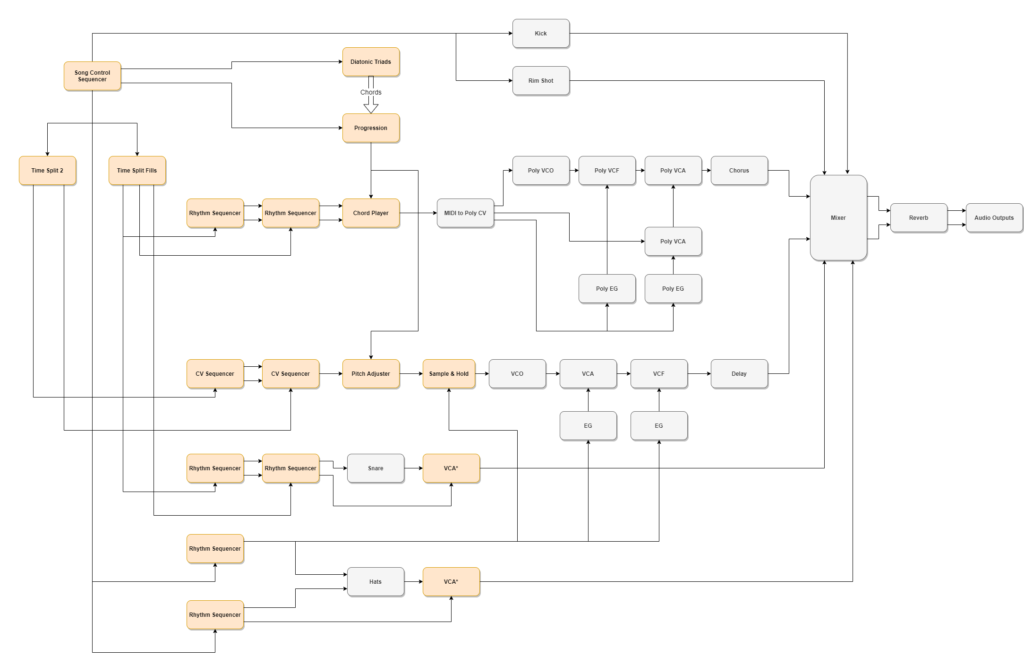
Although this patch is only an 8 bar loop it demonstrates several elements of how a section of a song might be constructed even without the more sophisticated facilities of LSSP XL.
The Chord Progression
This loop feels like it is going on a musical journey because of the chord progression. A minor key tonality provides emotional weight yet the final V chord, using a shift to major, gives it a classic dance music euphoric lift. The V-i transition then adds a powerful sense of turning around to the repetition.
| i | VI | i | VI |
| iv | ii dim | III | V |
This chord progression is implemented by patching cables from a Diatonic Triads module to a Progression module as shown below…
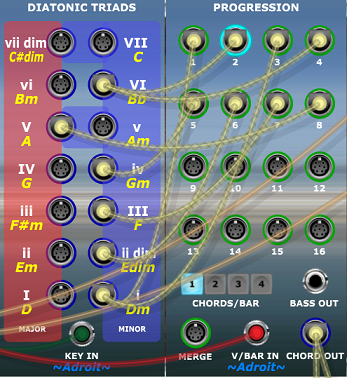
As we are only using simple three note chords there is not much harmonic texture in this loop. LSSP XL provides a much wider palette of chords but for the moment we are just using the basic facilities of LSSP 101.
The Mix
There are six elements in the mix and you can check these out by using the rather tiny Solo buttons on the Stereo Mixer module in the top right of the patch.
- Chord Stabs
- Plucks
- Rimshot
- Snare
- Kick
- Hats
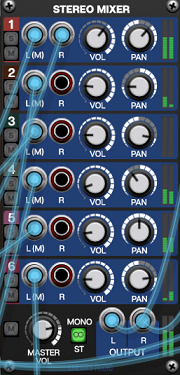
The kick and rimshot are super simple four to the floor hits that are triggered by the Song Control BEAT OUT signal.
The other elements (chord stabs, plucks, snare and hats) are discussed below.
Chord Player and Polyphony
Now we have the Voltage Modular Core modules to play with it’s possible to build patches with far more features. The main event in terms of Adroit modules is the ability to use the Chord Player module. This takes an S-Poly chord signal, a gate signal and an optional velocity signal and converts them into a series of MIDI note on and note off messages.
Although we touched on chords in Tutorial 3 we now have full access to polyphonic capabilities. The easiest way to get chords playing is to patch the MIDI OUT socket of Chord Player into the MIDI INPUT socket of a Plug-In Host module in order to play a VST or AU instrument.

You can even run Voltage Modular as a plug-in inside Voltage Modular and then simply load up one of the polyphonic presets to get going.
But in this tutorial we will use some of the standard polyphonic modules in Voltage Modular Core to demonstrate how polyphony can be handled directly – module by module.
Chord Stabs
The “chord stabs” on mixer channel 1 show Chord Player in action.
The Chord Player receives the current chord via an S-Poly cable connected to the CHORD OUT socket of the Progression module.
The rhythmical playing of the chord stabs is controlled by a pair of chained Rhythm Sequencers connected to the GATE IN and VEL IN sockets of the Chord Player.
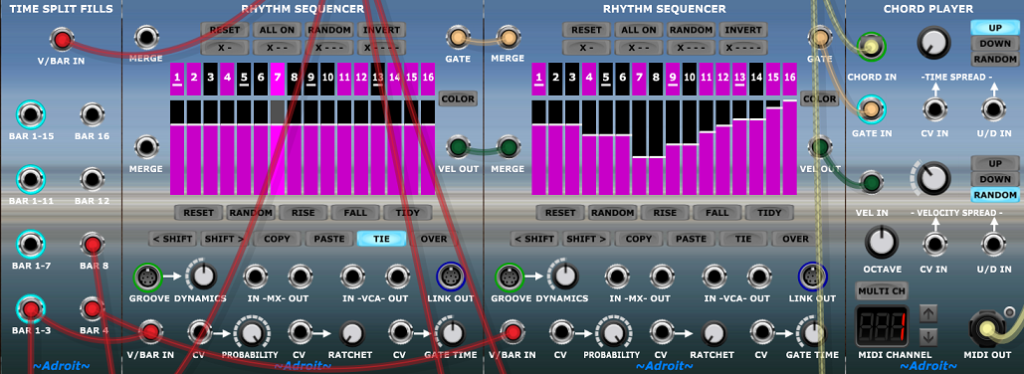
A Time Split Fills module is used to make the Rhythm Sequencers play the following 4-bar long pattern…
- left-hand sequence
- left-hand sequence
- left-hand sequence
- right-hand sequence
The Chord Player combines the chord, gate and velocity information and outputs MIDI note on and note off messages. Because the module’s VELOCITY SPREAD knob is turned up a little and RANDOM is selected the velocities of individual MIDI notes have a small random variation added that adjust the velocity information coming from the Rhythm Sequencers. This adds just a touch of extra interest to the dynamics.
Looking at the polyphonic section of the patch, the Chord Player MIDI OUT socket is connected to the MIDI IN socket of the Cherry Audio MIDI to Poly CV module.
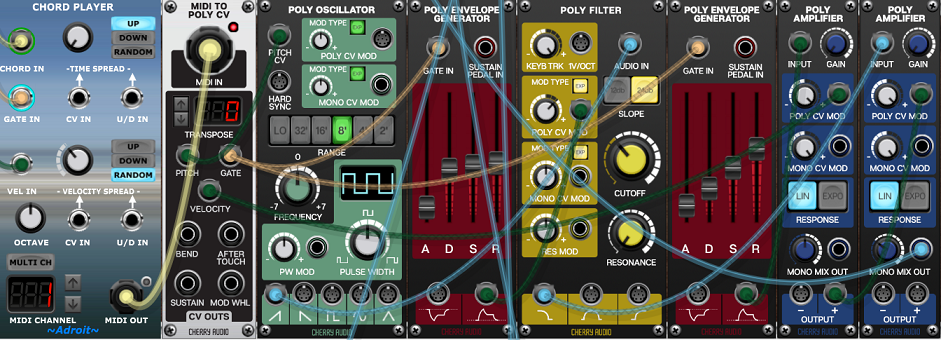
The MIDI to Poly CV module converts MIDI messages into control voltages. The key ones are available via the PITCH, GATE and VELOCITY outputs. Note these are standard Poly connections rather than S-Poly so you need to make sure that the NUMBER OF VOICES control on the I/O Panel is set high enough otherwise some notes may go missing. It defaults to 8 which is ample for this patch but in other patches you may need to increase the limit.
If you are using an older computer then it can make sense to limit polyphony in order to stop CPU overload. If you hear crackling sounds or drop outs then try lowering the NUMBER OF VOICES setting and/or increasing the audio buffer size in Settings.
The polyphonic pitch signal from the MIDI to Poly CV module feeds pitch information to a Poly Oscillator. The output of which feeds audio signals to the Poly Filter which then passes the filtered signals to a Poly Amplifier.
The polyphonic gate signals feeds two Poly Envelope Generators (one for the filter cut-off and another for a Poly Amplifier).
To have velocity control we need to modulate the second Poly Envelope Generator’s signals using another Poly Amplifier.
The final Poly Amplifier on the right has a convenient MONO MIX OUT which provides us with a mono audio signal that is fed via a Chorus module to the mixer.
Plucks
The “plucks” on mixer channel 2 are produced by a simple one oscillator mono synth that uses the Vintage Oscillator and Ladder Filter for a subtle change from the standard Oscillator and Filter. The output is then fed to the mixer via a Delay module that adds a slight echo effect.
The pitch of the oscillator is controlled by a two-bar long sequence produced by a pair of chained CV Sequencers being quantized to fit in the current chord via the Pitch Adjuster module.

The rhythm for the plucks is taken from the Rhythm Sequencer below (color-coded white).

This is producing a basic 1/8th note rhythm but because the PROBABILITY knob is turned down slightly some notes are randomly dropped. This adds a little variation.
Note that the GATE from this rhythm Sequencer is shared with the hats section. Such reuse can reduce the number of modules used and add some kind of shared feel. Also note that although some velocity information is programmed into this sequencer, it’s not currently being used.
Snare
The snare on mixer channel 4 is produced by the Transistor 808 Snare module.

The rhythm pattern is produced by a chain of two Rhythm Sequencers. They don’t have their own Time Splitter as they borrow V/Bar signals from the Time Split Fills module that’s used to produce the chord stabs pattern.
The left-hand sequencer gets its V/Bar signal from the BAR 1-3 output while the right-hand sequencer uses the BAR 8 output of the Time Split Fills module.
This produces the following snare pattern over an 8 bar period…
- left-hand sequence
- left-hand sequence
- left-hand sequence
- silence
- left-hand sequence
- left-hand sequence
- left-hand sequence
- right-hand sequence
The VCA built in to the right-hand Rhythm Sequencer receives all the velocity information for the sequence and is used to vary the volume of the snare.
Hats
The hats on mixer channel 6 are produced by the Transistor 808 Hats module. This has two trigger inputs, one for closed high hi-hat which is driven by the Rhythm Sequencer that’s color-coded blue and another for open hi-hat that’s driven by the Rhythm Sequencer color-coded white.

When the CHOKE button on the 808 Hats module is engaged a closed hat trigger overrides any open hat trigger. This is useful in that generally we want more closed hat sounds than open.
Although this arrangement looks a little bit complicated it was one of those things where one experiments for a little while and ends up with something that works. In this case I wanted a relatively regular pattern of closed hi-hats but with occasional silences or open hi-hats.
A cable from the blue sequencer’s VEL OUT socket to its own PROBABILITY input socket (and having the PROBABILITY knob turned down) means that the velocity bars on the sequencer control the probability of a gate happening.
As you can see from the height of the blue bars it’s pretty probable that a closed hat will be triggered on any of the strong beats (odd numbered steps) and less probable on the weaker beats (even numbered steps) except towards the end of the bar when weaker beats become more likely.
Although the white sequencer is firing on most 1/8th notes (which is useful for the plucks rhythm described above), it is only when the blue sequencer doesn’t fire that the 808 module’s choke mechanism allows an open hi-hat to sneak in.
The blue sequencer’s velocity information is also used to control the volume of the hats sounds because the output of the 808 Hats module is fed through the sequencer’s built-in VCA. This has an effect of making the weaker beats crescendo while the strong beats stay the same. It’s a subtle effect but gives the hat pattern a human feel.
Here’s a CV Watcher trace of a typical audio signal that’s produced…
